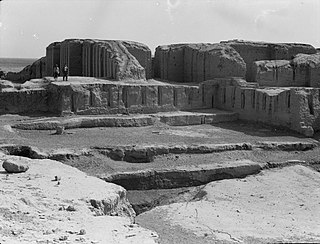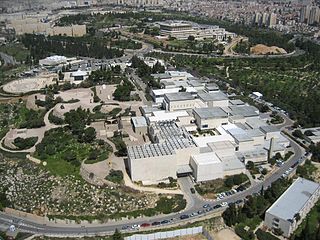Related Research Articles

Ur was an important Sumerian city-state in ancient Mesopotamia, located at the site of modern Tell el-Muqayyar in south Iraq's Dhi Qar Governorate in the Arabian Peninsula. Although Ur was once a coastal city near the mouth of the Euphrates on the Persian Gulf, the coastline has shifted and the city is now well inland, on the south bank of the Euphrates, 16 kilometres from Nasiriyah in modern-day Iraq. The city dates from the Ubaid period circa 3800 BC, and is recorded in written history as a city-state from the 26th century BC, its first recorded king being Mesannepada.

Kish is an important archaeological site in Babil Governorate (Iraq), located 80 kilometers south of Baghdad and 12 kilometers east of the ancient city of Babylon. The Ubaid period site of Ras al-Amiyah is 8 kilometers away. It was occupied from the Ubaid to Hellenistic periods. In Early Dynastic times the city's patron deity was Inanna with her consort Enki. Her temple, at Tell Ingharra, was (E)-hursag-kalama. By Old Babylonian times the patron deity had become Zababa, along with his consort, the goddess Bau. His temple Emeteursag was at Uhaimir.

The University of Pennsylvania Museum of Archaeology and Anthropology—commonly known as the Penn Museum—is an archaeology and anthropology museum at the University of Pennsylvania. It is located on Penn's campus in the University City neighborhood of Philadelphia, at the intersection of 33rd and South Streets. Housing over 1.3 million artifacts, the museum features one of the most comprehensive collections of middle and near-eastern art in the world.

The Israel Museum is an art and archaeological museum in Jerusalem. It was established in 1965 as Israel's largest and foremost cultural institution, and one of the world’s leading encyclopaedic museums. It is situated on a hill in the Givat Ram neighborhood of Jerusalem, adjacent to the Bible Lands Museum, the Knesset, the Israeli Supreme Court, and the Hebrew University of Jerusalem.

The Rockefeller Archeological Museum, formerly the Palestine Archaeological Museum, and which before then housed The Imperial Museum of Antiquities, is an archaeology museum located in East Jerusalem that houses a large collection of artifacts unearthed in the excavations conducted in the region of Palestine, mainly in the 1920s and 1930s.

Repatriation is the return of the cultural property, often referring to ancient or looted art, to their country of origin or former owners. The disputed cultural property items are physical artifacts of a group or society taken by another group, usually in the act of looting, whether in the context of imperialism, colonialism, or war. The contested objects vary widely and include sculptures, paintings, monuments, objects such as tools or weapons for purposes of anthropological study, and human remains.

The Istanbul Archaeology Museums are a group of three archaeological museums located in the Eminönü quarter of Istanbul, Turkey, near Gülhane Park and Topkapı Palace.

Looted art has been a consequence of looting during war, natural disaster and riot for centuries. Looting of art, archaeology and other cultural property may be an opportunistic criminal act or may be a more organized case of unlawful or unethical pillage by the victor of a conflict. The term "looted art" reflects bias, and whether particular art has been taken legally or illegally is often the subject of conflicting laws and subjective interpretations of governments and people; use of the term "looted art" in reference to a particular art object implies that the art was taken illegally.

Hagop Kevorkian was an Armenian-American archeologist, connoisseur of art, and collector. Originally from Kayseri, and a graduate of the American Robert College in Istanbul, he settled in New York City in the late 19th century, and was responsible for drawing greater attention to Near Eastern and Islamic artifacts in the United States.

Girsu was a city of ancient Sumer, situated some 25 km (16 mi) northwest of Lagash, at the site of modern Tell Telloh, Dhi Qar Governorate, Iraq.

The art of Mesopotamia has survived in the record from early hunter-gatherer societies on to the Bronze Age cultures of the Sumerian, Akkadian, Babylonian and Assyrian empires. These empires were later replaced in the Iron Age by the Neo-Assyrian and Neo-Babylonian empires. Widely considered to be the cradle of civilization, Mesopotamia brought significant cultural developments, including the oldest examples of writing.

The Nimrud ivories are a large group of small carved ivory plaques and figures dating from the 9th to the 7th centuries BC that were excavated from the Assyrian city of Nimrud during the 19th and 20th centuries. The ivories mostly originated outside Mesopotamia and are thought to have been made in the Levant and Egypt, and have frequently been attributed to the Phoenicians due to a number of the ivories containing Phoenician inscriptions. They are foundational artefacts in the study of Phoenician art, together with the Phoenician metal bowls, which were discovered at the same time but identified as Phoenician a few years earlier. However, both the bowls and the ivories pose a significant challenge as no examples of either – or any other artefacts with equivalent features – have been found in Phoenicia or other major colonies.

The Kelsey Museum of Archaeology is a museum of archaeology located on the University of Michigan central campus in Ann Arbor, Michigan, in the United States. The museum is a unit of the University of Michigan's College of Literature, Science, and the Arts. It has a collection of more than 100,000 ancient and medieval artifacts from the civilizations of the Mediterranean and the Near East. In addition to displaying its permanent and special exhibitions, the museum sponsors research and fieldwork and conducts educational programs for the public and for schoolchildren. The museum also houses the University of Michigan Interdepartmental Program in Classical Art and Archaeology.
Holly Pittman is a Near Eastern art historian and archaeologist, and an expert in Near Eastern glyptic art. She is the Bok Family Professor in the Humanities and a Professor in the History of Art Department of the University of Pennsylvania and serves as a curator in the Near East Section of the University of Pennsylvania Museum of Archaeology and Anthropology. Before joining the University of Pennsylvania, she was a curator of Ancient Near Eastern Art at the Metropolitan Museum of Art from 1974 to 1989. Since 1972, she has conducted archaeological excavations throughout the Middle East, including projects in Syria, Turkey, Cyprus, Iran, and Iraq. In 2019 she began directing new excavations at the site of Lagash in southern Iraq.
Grant Frame is a Canadian-American Assyriologist, Professor Emeritus of the University of Pennsylvania, and Curator Emeritus of the Babylonian Section of the University of Pennsylvania Museum of Archaeology and Anthropology. He is an expert on Akkadian language and literature and on the history and culture of ancient Mesopotamia in the first millennium BCE, in particular the Neo-Assyrian and Neo-Babylonian periods. Since 2008, he has served as Director and Editor-in-Chief of The Royal Inscriptions of the Neo-Assyrian Period (RINAP), an international research project funded by the U.S. government's National Endowment for the Humanities and other granting agencies, to translate the royal inscriptions of the rulers of Assyria from 744 to 609 BC. The RINAP project marks the continuation of the Royal Inscriptions of Mesopotamia (RIM) project, which Frame's teacher and mentor, Albert Kirk Grayson, founded at the University of Toronto in 1978 and led until his retirement with support from the Social Sciences and Humanities Research Council of Canada.

Phoenician metal bowls are approximately 90 decorative bowls made in the 7th–8th centuries BCE from bronze, silver and gold, found since the mid-19th century in the Eastern Mediterranean and Iraq. They were historically attributed to the Phoenicians, but are today considered to have been made by a broader group of Levantine peoples.
References
- ↑ British Museum.
- ↑ Research Archived 2014-07-14 at the Wayback Machine , SMB.museum.
- ↑ Article, The Guardian .
- ↑ 2005 Annual Report – Tableau récapitulatif de l’état d'avancement de l'informatisation des collections fin 2005, page 185.
- ↑ New exhibit Archived 2004-02-17 at archive.today , University of Chicago, 2003.
- ↑ Works of Art, Metropolitan Museum of Art, USA.
- ↑ Near East, University of Pennsylvania Museum of Archaeology and Anthropology.